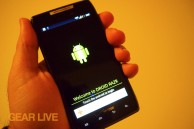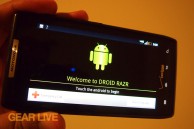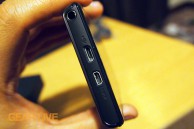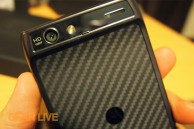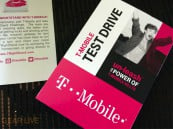Latest Gear Live Videos
Droid RAZR and RAZR MAXX Ice Cream Sandwich update roll-out starts now!

Posted by Andru Edwards Categories: Smartphones, Google, Handhelds, Software,

Motorola said a while ago that the Droid RAZR and RAZR MAXX would get an Android 4.0 Ice Cream Sandwich upgrade by the end of the second quarter. Well, it came down to the wire, but starting today RAZR owners will start receiving the Android 4.0.4 update. In addition to the new ICS feature set, the upgrade will also enable the Droid RAZR and RAZR MAXX with Global Ready mode, making the Verizon's first 4G LTE devices with that distinction. Go ahead and check for an update.
Read More  | Motorola
| Motorola
Advertisement
Verizon slashes price of Droid RAZR Maxx by $100

Posted by Andru Edwards Categories: Smartphones, Google, Handhelds, Hot Deals,

Verizon has just cut the price of the Droid RAZR Maxx by a whopping $100, bringing the price of the long-lasting 4G LTE smartphone down to $199.99 with two-year contract. That's a great price for the supercharged Motorola handset. Verizon is also touting its new partnership with Facebook video app Color, which allows you to share 30-second video snippets over 4G LTE. Speaking of the Droid RAZR Maxx, it should be picking up Android 4.0 Ice Cream Sandwich very, very shortly.
Click to continue reading Verizon slashes price of Droid RAZR Maxx by $100
Droid RAZR now available in blue from Verizon

Posted by Andru Edwards Categories: Smartphones, Design, Google, Handhelds,

Not feeling all the black and (sometimes) white Android devices out there? Well, prepare yourself, because Verizon has announced that a blue version of the Motorola Droid RAZR is on the way. Just to be clear, the only thing changing here is the color, so you'll get the same 4.3-inch display and Android 2.3 Gingerbread OS that all the other RAZRs are rocking. The blue model officially goes on sale next week, but you might be able to find it at physical Verizon stores a little sooner than that.
Ice Cream Sandwich coming to Droid RAZR, RAZR Maxx, HTC Rezound this week

Posted by Andrey Malskiy Categories: Smartphones, Rumors, Software,

Thanks to a leaked image from a Best Buy, it appears that we now know that the Motorola Droid RAZR and RAZR MAXX, alongside the HTC Rezound, will be receiving an Ice Cream Sandwich update. April 4th is the day for RAZR devices, and April 6th is when the Rezound gets in on the Android 4.0 action. The update will be available over the air, but we have no idea on the rollout schedule. By the looks of it, April is turning out to be a big month for smartphones and updates.
Read More  | Android Police
| Android Police
Unboxing Live 087: Droid RAZR MAXX

Posted by Andru Edwards Categories: Cell Phones, Features, Handhelds, Videocasts,
In this episode we give you a look at the Motorola Droid RAZR MAXX. This is a follow-up to the Droid RAZR, with the major difference being that the RAZR MAXX packs in a 3300 mAh battery. The result? The RAZR MAXX has twice the battery life of the Droid RAZR that was just released a couple of months ago. In fact, this is the first 4G LTE smartphone that we've found that doesn't have horrible battery life. With the Droid RAZR MAXX, you can count on the battery to last all day and night, which is a welcome change from what we've found with other 4G smartphones. It's also got an 8 megapixel camera that records 1080p, and the front camera records 720p as well. It's also got a 1.2 GHz dual core processor. You can pick up the Droid RAZR MAXX for $299.
Big thank you to GoToMeeting and JackThreads for sponsoring the show - be sure to check them out! GoToMeeting with HDFaces provides rich, super-simple collaborative virtual meetings. As for JackThreads, we've got exclusive invite codes that give you $5 to use towards anything you'd like on the site.
Google’s Android Update Alliance not living up to expectations

Posted by Andru Edwards Categories: Smartphones, Google, Software,
At the Google I/O conference in May, many Android phone vendors and U.S. wireless carriers made a long-awaited promise: From then on, any new Android phone would receive timely OS updates for at least 18 months following launch, as part of the then newly christened Google Update Alliance.
The back story: If you own an Android phone, you may have watched with frustration as a new version of the OS hit the market. It's almost never clear if your phone will ever get that upgrade—unlike with iOS or Windows Phones, which always get all upgrades (providing they meet the right hardware requirements). With Android, it seems to depend on the phone vendor, the specific model, the wireless carrier, the Android version itself, and whether Google sent the carrier an inflatable plastic food product as a token of its appreciation that week. Worse—and much to our chagrin—sometimes vendors make promises to customers before the sale that they don't keep once you own the phone.
Many factors contribute to this. But custom versions of Android are the key culprit, either thanks to vendor-specific enhancements (like HTC Sense, Motorola MotoBlur, and Samsung's TouchWiz, though LG, Pantech, Casio, and other vendors do it too), or carrier-specific enhancements of a more dubious nature (such as unnecessary preloaded bloatware and changes to default apps). These changes require many programming hours not just to make in the first place, but to also support and upgrade down the road—resources the carrier would rather throw at making new phones to sell you.
So the Google Update Alliance was a breath of fresh air. It sounded like everyone would finally come together, streamline their OS update timelines, and stop jerking around their customers. The thing is, while the Google Update Alliance ended up being one of the biggest stories to come out of Google I/O, we've heard almost nothing about it since then. You can bet we weren't just going to forget about it and pretend it never happened—especially after the release of Google Android 4.0 (Ice Cream Sandwich), which is a huge leap in UI design and overall performance.
Click to continue reading Google’s Android Update Alliance not living up to expectations
Motorola Droid RAZR unboxing gallery

Posted by Andru Edwards Categories: Cell Phones, Features, Galleries, Handhelds,
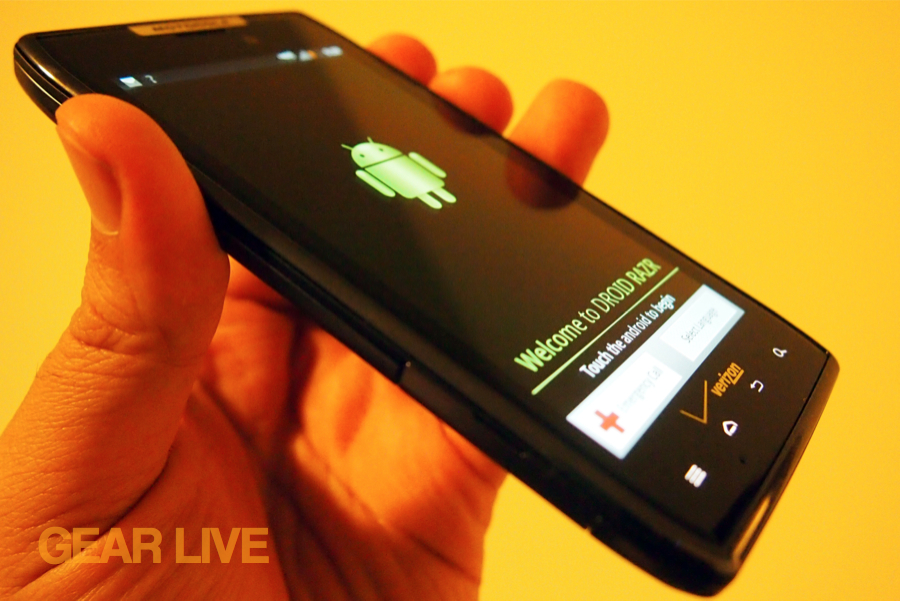
Motorola has ressurrected the RAZR from the dead, slapped the Droid branding on it, and has come up with a 7.1mm thin powerhouse. Appropriately called the Droid RAZR, the smartphone has a Gorilla Glass covered 4.3-inch qHD Super AMOLED display and a body made of Kevlar, making it lightweight, water-resistant, and durable. On the inside you've got a dual-core 1.2GHz TI OMAP4430 chip, 8 megapixel camera that records 1080p video, 1 GB RAM, and 16 GB flash storage onboard (and another 16 GB on the included microSD card.) It runs on Verizon's 4G LTE network. so you know, it's fast. We'll be getting a review up soon, but in the meantime, be sure to peep our Droid RAZR unboxing gallery first!
Gallery:
Motorola Droid RAZR: 4G LTE, 4.3-inch qHD Super AMOLED screen, $299 this November

Posted by Andru Edwards Categories: Smartphones, Google, Handhelds,

Today Motorola announced the return of their most popular brand ever when they unveiled the Droid RAZR smartphone. The RAZR isn't just another Android handset, and you know they Motorola wouldn't just slap that name on any average device. This one has a Gorilla Glass covered 4.3-inch qHD Super AMOLED display (this has not been seen on any other mobile phone to date,) and a body made of Kevlar, making it lightweight, water-resistant, and durable. On the inside you've got a dual-core 1.2GHz TI OMAP4430 chip, 8 megapixel camera that records 1080p video, 1 GB RAM, and 16 GB flash storage onboard (and another 16 GB on the included microSD card.) It also runs on Verizon's 4G LTE network.
Motorola's also tried to make the phone as thin as they could, touting that it's just 7.1mm thin, but that doesn't take into account the thicker bottom area. Who's counting, right? One other nice feature is the addition of something Moto's calling SmartActions. It's meant to preserve and optimize battery life by doing things like turning off Bluetooth when you get home, or clocking down the processor while you're on a phone call.
You'll be able to squeeze out 12.5 hours of talk time when this bad boy hits Verizon this November 6th, and it'll cost you $299 for the priviledge. Pre-orders start October 27th.


